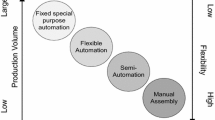Abstract
Flexible material handling systems (FMHS) have been widely used to enhance productivity involved with product proliferation, and thus far, only fixed-track material handling systems such as Eton systems in the apparel industry are commonly used. This paper explores the potential advantages of a FMHS using free-ranging automated-guided vehicles with a local positioning system for the apparel industry. First, the free-ranging FMHS (FRMHS) for the apparel industry has been designed. Then, through Monte Carlo simulation and analytical models, the performance in terms of manufacturing system effectiveness, workstation utilization, and the total transportation distance of the FRMHS are compared with those of the fixed-track system. Based on our analysis, the current proposed FRMHS can have significant advantages over the fixed-track system.
Similar content being viewed by others
References
Paraschidis K, Fahantidis N, Petridis V, Doulgeri Z, Petrou L, Hasapis G (1994) Robotic system for handling textile and non rigid flat materials. Comput Ind 26(3):303–313. doi:10.1016/0166-3615(95)00022-V
Beamon BM (1998) Performance, reliability, and performability of material handling systems. Int J Prod Res 36(2):337–393. doi:10.1080/002075498193796
Jawahar N, Aravindan P, Ponnambalam SG, Suresh PK (1998) AGV schedule integrated with production in flexible manufacturing systems. Int J Adv Manuf Technol 14(6):428–440. doi:10.1007/BF01304622
Tompkins JA, White JA, Bozer YA, Frazelle EH, Tanchoco JMA, Trevino J (2002) Facilities planning. Wiley, New York
Datamonitor (2007, March) Consumer durables & apparel industry profile: global. Retrieved April 6, 2008, from Business Source Premier Database
Census and Statistics Department, The government of Hong Kong Special Administrative Region (2007) Industry production: principal statistics for all manufacturing establishments by major industry group. Available via DIALOG. http://www.censtatd.gov.hk/hong_kong_statistics/statistical_tables/index.jsp?charsetID=1&subjectID=4&tableID=100. Cited 15 May 2008
HKTDC (2008) Industry focus garments: clothing. Available via DIALOG. http://garments.hktdc.com/content.aspx?data=garments_content_en&contentid=173975&w_sid=194&w_pid=679&w_nid=11802&w_cid=1&w_idt=1900-01-01. Cited 15 May 2008
Chin KS, Pun KF, Lau H, Leung YS (2004) Adoption of automation systems and strategy choices for Hong Kong apparel practitioners. Int J Adv Manuf Technol 24(3-4):229–240. doi:10.1007/s00170-003-1592-3
Witt CE (1995) Automated material handling: breakthrough in textile industry. Mater Handl Eng 50(1):48–52
Lin H, Taylor PM, Bull SJ (2007) Modeling of contact deformation for a pinch gripper in automated material handling. Math Comput Model 46(11–12):1453–1467. doi:10.1016/j.mcm.2007.02.019
Ragunathan S, Karunamoorthy L (2006) Modeling and dynamic analysis of reconfigurable robotic gripper system for handling fabric materials in garment industries. J Adv Manuf Syst 5(2):233–254. doi:10.1142/S0219686706000820
Tait N (1996) Materials handling in the garment factory. Apparel Int 27(5):20–23
Aldrich J (1995) Flexible materials handling. Appar Ind Mag 56(5):47–49
Beason M (1999) Here’s a new material handling solution. Textile World 149(2):61–63
Hill JE (1994) A study of the cost and benefits of a unit production system versus the progressive bundle system. Clemson Apparel Research Facility Pendleton SC. Available via DIALOG. http://handle.dtic.mil/100.2/ADA299226. Cited 10 May 2008
Tait N (2004) How to reduce: materials handling costs. Apparel 45(10):28–32
Tait N (2007) How to cut down on handling time. Fashion Business International Apr–May: 52–55
Muller T (1983) Automated guided vehicles. IFS Publications, UK
Egbelu PJ (1993) Concurrent specification of unit load sizes and automated guided vehicle fleet size in manufacturing system. Int J Prod Econ 29:49–64. doi:10.1016/0925-5273(93)90023-E
Mahajan A, Figueroa F (1999) Automatic self-installation and calibration method for a 3D position sensing system using ultrasonics. Robot Auton Syst 28(4):281–294. doi:10.1016/S0921-8890(99)00042-1
Chittratanawat S, Noble JS (1999) An integrated approach for facility layout, P/D locations and material handling system design. Int J Prod Res 37(3):683–706. doi:10.1080/002075499191733
Kim JG, Goetschalckx M (2005) An integrated approach for the concurrent determination of the block layout and the input and output point locations based on the contour distance. Int J Prod Res 43(10):2027–2047. doi:10.1080/00207540412331333432
Fogarty DW (1992) Work in process: performance measures. Int J Prod Econ 26(1–3):169–172. doi:10.1016/0925-5273(92)90059-G
Viswanadham N, Narahari Y (1992) Performance modeling of automated manufacturing systems. Prentice-Hall, Englewood NJ
Saad SM, Byrne MD (1998) Comprehensive simulation analysis of a flexible hybrid assembly system. Integr Manuf Syst 9(3):156. doi:10.1108/09576069810210394
Egbelu PJ, Tanchoco JMA (1984) Characterization of automatic guided vehicle dispatching rules. Int J Prod Res 22(3):359–374. doi:10.1080/00207548408942459
Maione B, Semeraro Q, Turchiano B (1986) Closed analytical formulae for evaluating flexible manufacturing system performance measures. Int J Prod Res 24(3):583–592. doi:10.1080/00207548608919751
No author name available (2006) Materials handling: adding cost—with no added value. Textile Network 1–2:16–19
Smith JS (2003) Survey on the use of simulation for manufacturing system design and operation. J Manuf Syst 22(2):157–171. doi:10.1016/S0278-6125(03)90013-6
Beamon MB, Chen VCP (1998) Performability-based fleet sizing in a material handling system. Int J Adv Manuf Technol 14(6):441–449. doi:10.1007/BF01304623
Wong WK, Leung SYS, Au KF (2005) Real-time GA-based rescheduling approach for the pre-sewing stage of an apparel manufacturing process. Int J Adv Manuf Technol 25(1–2):180–188. doi:10.1007/s00170-003-1819-3
Wong WK, Mok PY, Leung SYS (2006) Developing a genetic optimization approach to balance an apparel assembly line. Int J Adv Manuf Technol 28(3–4):387–394. doi:10.1007/s00170-004-2350-x
Author information
Authors and Affiliations
Corresponding author
Rights and permissions
About this article
Cite this article
Dai, J.B., Lee, N.K.S. & Cheung, W.S. Performance analysis of flexible material handling systems for the apparel industry. Int J Adv Manuf Technol 44, 1219–1229 (2009). https://doi.org/10.1007/s00170-008-1916-4
Received:
Accepted:
Published:
Issue Date:
DOI: https://doi.org/10.1007/s00170-008-1916-4




